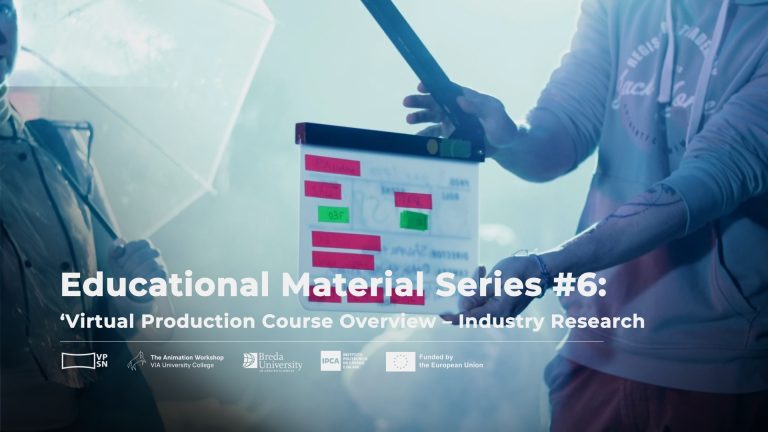Introducing the Virtual Production Studio Network Course for Educators
Welcome to the second article in our web series on the Virtual Production Studio Network (VPSN) course overview and teaching material spotlight!
This article is specifically designed for educators, highlighting some of the benefits of virtual production. We’ll also provide practical insights on how to understand and approach this technology in your teaching, even if integrating it into your curriculum presents challenges due to the need for specialized equipment and facilities.
Why Virtual Production Matters in Education
Virtual production is revolutionizing the media industry, offering innovative ways to create films, games, and digital content. Or looked at in reverse: Virtual production is the result of integrating emerging technology into existing workflows and film industry toolkits, enabling efficiency and new methods of film production through real-time technologies.
While incorporating this technology into your curriculum may be challenging due to the need for large facilities, significant investment into equipment, and specialized knowledge, there is still immense value in familiarizing yourself and your students with these concepts and technologies.
Here’s why educators should consider exploring this course:
- New Knowledge and Skills: Students would benefit from learning the fundamentals of virtual production, including Unreal Engine, camera tracking, and lighting techniques unique to virtual production. These skills are highly sought after in the digital media industry.
- Career Recruitability: Equipping students with virtual production skills can prepare them for a rapidly evolving job market, enhancing their employability in fields like film, animation, and visual effects.
- Traditional Studio Filmmaking is Evolving: Virtual production is changing the industry, and tools get replaced frequently. Wihel, arguably, VP is still an emergent technology, it is already taking over a lot of traditional tools currently taught in most curricula covering basic and advanced filmmaking principles.
Key Considerations for Educators
Before integrating the VPSN course into your curriculum, there are several factors to consider. The course material includes specific sections and questions designed to help educators navigate this process:
- Situational Factors (Section 1.2 in the course overview): This section discusses the context of the learning environment, including class size, course level, meeting frequency, and delivery method. Understanding these factors is crucial for effectively implementing the course.
- Course ILOs and Assessments (Section 2 in the course overview): The course outlines clear Intended Learning Objectives (ILOs) and assessment criteria. These objectives focus on developing students’ ability to produce virtual production films, compare traditional and virtual production methods, reflect on their learning, and establish professional relationships.
Understanding Virtual Production Without Equipment
One of the challenges of teaching virtual production is the need for specialized equipment.
However, the VPSN course provides several resources and materials to support learning without physical equipment:
- Theoretical Components: The course includes comprehensive lecture materials that cover the theoretical aspects of virtual production. Educators can use these materials to teach concepts such as Unreal Engine basics, camera tracking, and lighting techniques.
- Online Resources: The VPSN project offers a variety of online resources, including video tutorials, books, and templates for production documents. These resources can help educators teach virtual production concepts without the need for physical equipment.
- Practical Examples: Educators can use case studies and examples from the course to illustrate virtual production techniques. This helps students understand the practical applications of the concepts they are learning.
Benefits for Educators and Students
- Enhanced Curriculum: Integrating virtual production into your curriculum can make your program more attractive to prospective students – and particularly industry partners.
- Lifelong Learning: Understanding virtual production fosters adaptability and continuous learning, essential traits in an industry that is constantly evolving and integrating new technologies.
- Professional Development: Educators can stay updated with the latest industry trends and technologies, enhancing their own professional development.
Wrapping up ‘#2 For Educators’
We invite educators to explore the VPSN course materials and integrate virtual production into their curriculum. The full educational package is available on the VPSN website, providing comprehensive resources and support for teaching virtual production. By incorporating this course into your program, you can prepare your students for the future of media production and help them develop the skills needed to succeed in the digital media industry.
About VPSN
The VPSN project is an Erasmus+ initiative, collaboratively developed by three partners: The Animation Workshop/VIA University College, Breda University of Applied Sciences, and the Polytechnic Institute of Cávado and Ave. This partnership aims to create educational materials and frameworks for other educators and students, leveraging Breda University’s extensive experience in virtual production. By sharing this knowledge, the VPSN project seeks to support the European industry and educational field, particularly those interested in virtual production as an emergent technology.



